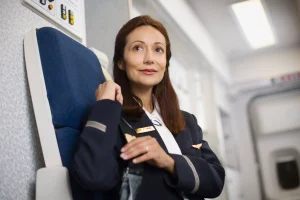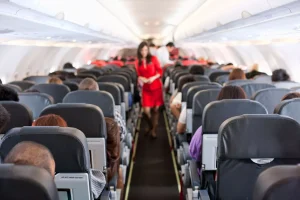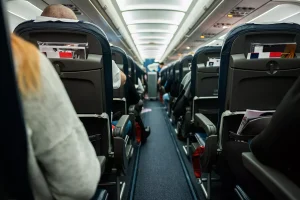If you’ve ever seen flight attendants sitting still during takeoff or landing, with their feet flat on the ground and their hands tucked behind their thighs, you may have wondered: What are they doing? It turns out that things are more complicated than they first appear.

Instead of doing nothing, flight attendants are carrying out a discreet but crucial safety procedure that is meant to help them be ready for the worst while also hoping for the best.
The “silent review” or “30-second review” is a behind-the-scenes procedure that includes this sitting stillness. The silent assessment is carried out at each takeoff and landing, two of the riskiest flying periods, according to flight attendant Henny Lim of Cebu Pacific in the Philippines.
In a widely shared TikTok post, Lim clarified, “This act [during] every takeoff and landing prepares us for an emergency situation.”
The position and operation of emergency exits, emergency equipment at their station, specific roles during an evacuation, visual clues outside the aircraft (such as fire, smoke, or debris), and directions they might have to deliver to passengers are all reviewed in the minds of flight attendants.

This mental checklist isn’t just for planning; it also makes people feel less anxious and allows them to act quickly in case of an emergency. All members of the in-flight crew are strongly encouraged to follow this procedure by Airbus, one of the top aircraft manufacturers in the world. The silent review reduces distraction, improves preparedness, and helps avoid the “startle effect,” which is the disorientation that can happen in an unexpected crisis, according to their safety recommendations.
In addition to the silent evaluation, flight attendants adopt a tactful yet deliberate bracing posture. This is the point at which they sit on their hands.
According to Lim, the position entails sitting up straight, tucking in the thumbs to prevent harm, keeping feet flat on the ground, positioning hands palms up beneath the thighs, and securely tightening the seat belt.

In the event of an unexpected emergency, Lim stated, “the goal is to maintain the body in a rigid position so that the body sustains less damage.” “By restricting body movement, this lowers the risk of injury in the event of an impact.”
By stabilising them against unexpected forces, this technique safeguards important body parts, especially the arms, wrists, and face.
Depending on the aircraft model and seat orientation, the bracing posture may also require particular head placements, according to Hilary Clark, director of in-flight services for private airline operator Planet 9, who spoke to Travel + Leisure.

For instance, attendants rest their heads against the headrest when the jump seat is facing the back, or the back of the aircraft. Another variation of the bracing position is to tuck the chin in and bow slightly if the seat is facing forward.
These minor variations are intended to provide the best head and neck protection in the case of an abrupt halt or collision.
flight attendants are on high alert throughout takeoff and landing, while passengers may be unwinding or using their phones. As soon as they fasten their seatbelts, their training begins, silently going over emergency procedures, looking around the cabin, and psychologically and physically preparing.
The next time you see a member of the crew sitting with their hands tucked under their thighs, you’ll know that they’re standing ready rather than just sitting motionless.
